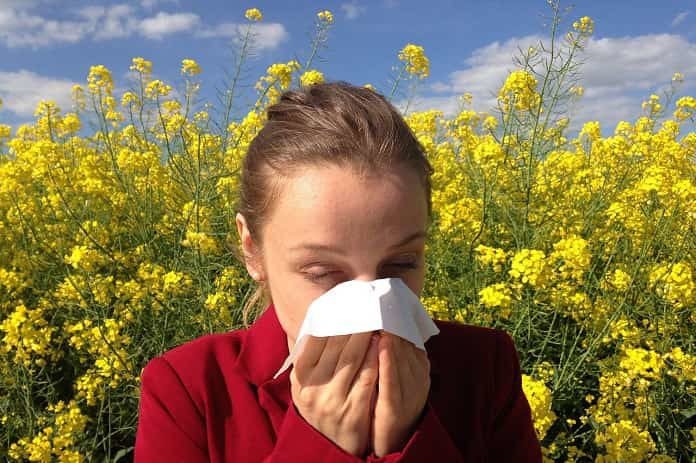Researchers at the University of Copenhagen in Denmark are developing a new hay fever treatment using genetically engineered vaccines targeting specific allergic reactions.
One method of preventing or reducing allergic reactions to is to induce tolerance with allergen immunotherapy. Allergen immunotherapy involves exposing patients who are allergic to specific substances to increasing dosing of the allergens. The goal behind this therapy is a reduction or disappearance in allergy symptoms over time. A limitation of allergen immunotherapy is the long duration required before tolerance is established. Researchers from the Faculty of Health and Medical Sciences at the University of Copenhagen in Denmark are developing a new vaccine for hay fever treatment. They recently published their study in the Journal of Allergy and Clinical Immunology.
New vaccine contains hay fever allergens attached to sugar molecules
The new vaccine contains hay fever allergens attached to sugar molecules that can target specific immune cells. Researchers added a sugar molecule to the Bet v 1 which is a common allergen causing symptoms of hay fever. The goal of this treatment is to induce a specific immune response in mice and develop a vaccine model for hay fever treatment in humans.
Step 1: Choosing the appropriate sugar molecule
The first testing involved choosing the appropriate sugar molecule to attach to the allergen to induce the greatest immune response. The immune response was defined in these tests as the uptake of the sugar molecules into the immune cells. Among five different sugar molecules, the immune cells were more responsive to GalNAc and mannose type molecules. The researchers, therefore, used these sugar molecules in their vaccine model. In theory, allergens attached to these sugar molecules will be more easily taken up and removed by the targeted immune cells.
By labeling the allergen with a fluorescent dye, the researchers were able to see Bet v 1 enter into the immune cell. The Bet v 1 allergen that was attached to the GalNAc and mannose structures were inserted into the immune cells more readily than the Bet v 1 allergens that were bound to a non-sugar molecule. These tests confirm that in mice models GalNAc and mannose molecules attached to an allergen will be easily take up by specific immune cells. However, the uptake of the allergen into the immune cell does not necessarily mean an immune response will be established.
Step 2: Detect an immune response
The next step for the researchers was to detect an immune response following the uptake of the allergen into the immune cells. Upon the first exposure to an allergen, primary T cells in the body reproduce themselves with slight modifications in their structure. These T cells are stored in the body for future exposure to an array of different allergens.
A primary immune response was quantified in these laboratory tests by the level of reproduction of a specific primary T cell and the release of an immune factor, the cytokines. Following uptake of Bet v 1 allergen, the T cell reproduction was significantly increased compared to the cells exposed to the allergen that was not attached to a sugar molecule. Cytokine release showed less conclusive results as both anti-inflammatory cytokines and proinflammatory cytokines were released.
Step 3: Testing the vaccine in animal studies
Lastly, the researchers tested their vaccine model in a group of mice that experience hay fever. The mice were pretreated with the Bet v 1 allergen attached to the GalNAc sugar molecule to induce the primary immune response. This test of the function of the developed hay fever treatment helped to quantify the immune response in the mice injected with the vaccine model compared with the response in mice injected with a non-sugar bound vaccine.
The mice injected with the sugar-bound vaccine following the primary exposure to Bet v 1 showed a reduced immune response compared with the mice injected with the non-sugar bound vaccine. The reduced immune response was also seen after these mice were exposed again to natural Bet v 1 extracts. In these laboratory tests, the vaccine induced a tolerance to Bet v 1 in mice.
Promising results in a laboratory setting
In conclusion, these first studies on this new hay fever treatment show promising results in a laboratory setting. Further studies are required to establish a database of sugar molecules to target different cells in the immune system. The application of this method of targeted induction of tolerance can also be used in other treatments areas such as oncology and autoimmune diseases.
Written by Jessica Caporuscio, PharmD
References:
- Mathiesen CBK, Carlsson MC, Brand S, et al. Genetically engineered cell factories produce glycoengineeredvaccines that target antigen-presenting cells and reduce antigen-specific T-cell reactivity. J Allergy Clin Immunol. 2018
- Call ME. Antigen-presenting cells. Uptodate Wolturs Kluwer. 2017.
- Moran TP, Burks AW. Is clinical tolerance possible after allergenimmunotherapy? Curr Allergy Asthma Rep. 2015.
- University of Copenhagen The Faculty of Health and Medical Sciences. New allergy vaccine for hay fever shows promising results. Press Release. 2018 sept 26. https://www.eurekalert.org/pub_releases/2018-09/uoct-nav092618.php



